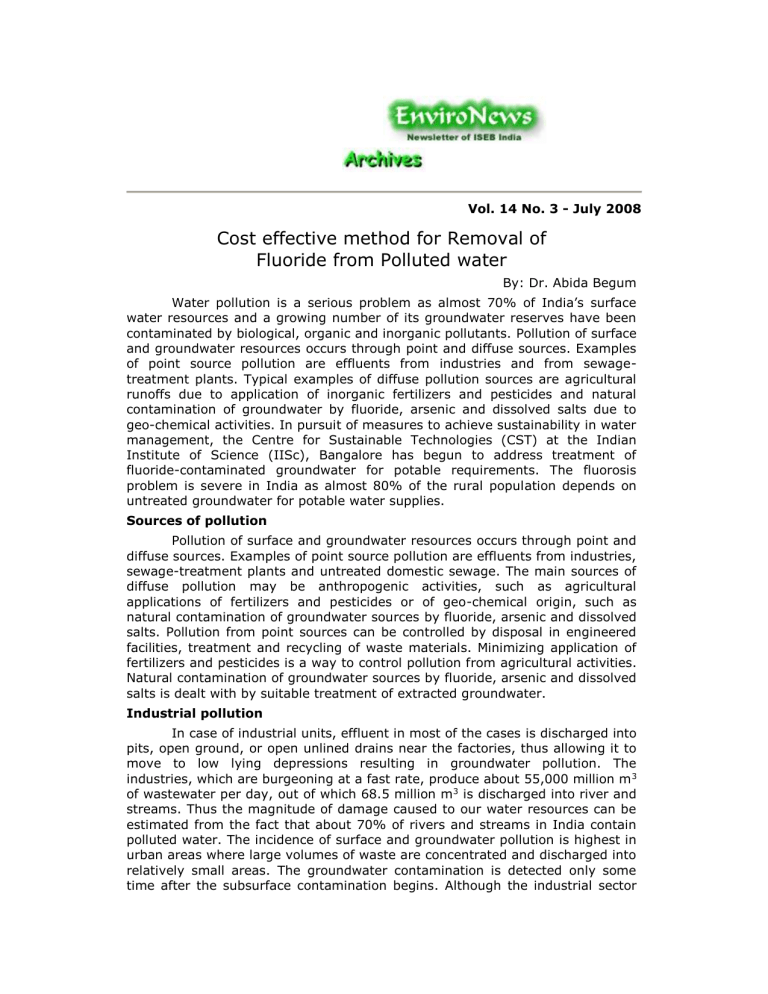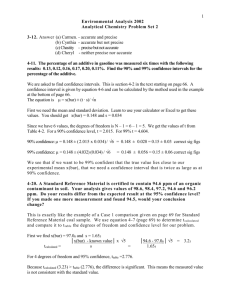water-flouride - India Environment Portal

Vol. 14 No. 3 - July 2008
Cost effective method for Removal of
Fluoride from Polluted water
By: Dr. Abida Begum
Water pollution is a serious problem as almost 70% of India’s surface water resources and a growing number of its groundwater reserves have been contaminated by biological, organic and inorganic pollutants. Pollution of surface and groundwater resources occurs through point and diffuse sources. Examples of point source pollution are effluents from industries and from sewagetreatment plants. Typical examples of diffuse pollution sources are agricultural runoffs due to application of inorganic fertilizers and pesticides and natural contamination of groundwater by fluoride, arsenic and dissolved salts due to geo-chemical activities. In pursuit of measures to achieve sustainability in water management, the Centre for Sustainable Technologies (CST) at the Indian
Institute of Science (IISc), Bangalore has begun to address treatment of fluoride-contaminated groundwater for potable requirements. The fluorosis problem is severe in India as almost 80% of the rural population depends on untreated groundwater for potable water supplies.
Sources of pollution
Pollution of surface and groundwater resources occurs through point and diffuse sources. Examples of point source pollution are effluents from industries, sewage-treatment plants and untreated domestic sewage. The main sources of diffuse pollution may be anthropogenic activities, such as agricultural applications of fertilizers and pesticides or of geo-chemical origin, such as natural contamination of groundwater sources by fluoride, arsenic and dissolved salts. Pollution from point sources can be controlled by disposal in engineered facilities, treatment and recycling of waste materials. Minimizing application of fertilizers and pesticides is a way to control pollution from agricultural activities.
Natural contamination of groundwater sources by fluoride, arsenic and dissolved salts is dealt with by suitable treatment of extracted groundwater.
Industrial pollution
In case of industrial units, effluent in most of the cases is discharged into pits, open ground, or open unlined drains near the factories, thus allowing it to move to low lying depressions resulting in groundwater pollution. The industries, which are burgeoning at a fast rate, produce about 55,000 million m 3 of wastewater per day, out of which 68.5 million m 3 is discharged into river and streams. Thus the magnitude of damage caused to our water resources can be estimated from the fact that about 70% of rivers and streams in India contain polluted water. The incidence of surface and groundwater pollution is highest in urban areas where large volumes of waste are concentrated and discharged into relatively small areas. The groundwater contamination is detected only some time after the subsurface contamination begins. Although the industrial sector
accounts for only 3% of the annual water withdrawals in India, its contribution to water pollution, particularly in urban areas, is considerable.
Pollution from domestic activities
Inadequate treatment of human and animal wastes contributes to the high incidence of water-related diseases in the country. To date, only 14% of rural and 70% of urban inhabitants have access to adequate sanitation facilities.
Fluorine, a fairly common element of the earth’s crust, is present in the form of fluorides in a number of minerals and in many rocks. Excess fluoride in drinking water causes harmful effects such as dental fluorosis and skeletal fluorosis. The permissible limit of fluoride level is generally 1ppm. The high fluoride levels in drinking water and its impact on human health in many parts of India have increased the importance of defluoridation studies. The fluoride -bearing minerals or fluoride-rich minerals in the rocks and soils are the cause of high fluoride content in the groundwater, which is the main source of drinking-water in India.
A study was conducted to find a suitable low-cost environmentally friendly method for the removal of fluoride in the groundwater that is used by common man. A few natural materials such as pea-nut shell carbon, Bombax
malabaricum carbon, untreated charcoal, fly-ash from bagasse and MgO
2 maintained at PH 8.5 were used. The capacity of fluoride removal by the individual materials was studied and accordingly five columns were set up and studied for their defluoridation capacities.
Methodology
The fly-ash from bagasse has oxides of Si, Al, Fe, Ti, Ca, MgSO and alkalies along with mixed oxides.
3
The pea nut shell and dried fruits of Bombax malabaricum were carbonized in the electrical conventional heating reactor by two stages carbonization process in the range of 250-600 o C and 600-700 o C respectively. The materials were placed in closed stainless steel vessel by maintaining inert conditions and pyrolysis was carried out at 40 o C for
30 minutes followed by next stage to develop the pore size structure.
Powdered untreated charcoal and MgO
2
were used.
All the materials used for defluoridation were treated with 0.5 M HNO
3 for the removal of unwanted materials. The acid washed product was thoroughly washed with hot distilled water to remove acidity and chlorides. The products were finally dried. All chemicals were of analytical reagent grade, and distilled water was used throughout. The standard solutions were prepared
1mg/L, 5 mg/L 10mg/L 15mg/L and 20 mg/L using DDW (the pH maintained was 8.5 HCO
3
-2.1 mg/L, Ca 1.2 mg/L, SO were conducted at 23
4
0.43 mg/L). Sorption experiments o C in a column packed with 450 g of each material
(Bombax malabaricum carbon, untreated charcoal, fly-ash from bagasse and
MgO
2
) The concentrations of fluoride in water fed on the columns were 1, 5, 10, and 20 mg/l. 250 ml of a fluoride solution was first poured into the column to moisten the natural material. Then a 250-mL portion of the solution was placed in the top reservoir and the draining rate was adjusted to ca 2.0 ml/hr. Each experiment with solution of a given concentration was run with a fresh portion of each natural material. The stopper was adjusted at a standard rate of 1.5 ml
/min. The samples were collected at intervals of 20, 40, 60, 80, 120 and 140 minutes. The fluoride level in the effluent was monitored potentiometrically by using a fluoride ion-selective electrode. Further 5 locations of ground water
were analyzed. From each location 3 samples were taken and tested for fluoride concentration before and after treatment. The results showed that all the samples were found to be within desirable limit of fluoride concentration of
Indian standards but for untreated charcoal where the fluoride concentration was above permissible limit.
The results showed that the sorption of fluoride increases with increasing concentration of incoming solution. Pure water leaches fluoride for all the five materials may be due to formation of fluoride complexes. When a solution with low fluoride concentration (1 mg/l) is passed through the column, the fluoride level in the effluent was nil in the case of peanut shell carbon, fly-ash and MgO
2 at 80 minutes. However, after 120 minutes the effluent becomes completely free of fluoride in all the columns.
It is remarkable that the retention capacity of the natural materials increases with increasing fluoride concentration in incoming solution. . For the
5, 10 and 20 mg/l F concentrations the respective drops in F concentration are
27, 58 and 76.5 per cent. Complete retention of the fluoride by fly ash occurs after 100 minutes for the lower F -
120 minutes for the higher F concentrations (1, 5, and 10 mg/l) and after
concentrations. The rate of adsorption is controlled by the rate of diffusion of fluoride in the inter-capillary pores of the particles. In the case of charcoal treatment the retention of fluoride did not change significantly with time, although there was some defluoridation at the initial stage. Strong sorptive capacity of residual carbon in the natural materials used, may be due to the fact that residual carbon samples showed signs of significant oxidation that has led to highly porous and fragmented particle structures. Hence all the materials used in the experiment are good sorpbents except untreated charcoal. Further, ground water from five locations were analyzed. From each location 3 samples were taken and tested for fluoride concentration before and after treatment. The results revealed that after the treatment the samples were found to be within desirable limit of fluoride concentration of Indian standards except in the case of untreated charcoal the fluoride concentration was above permissible limit. It is a preliminary experiment and it needs further research.






